Tak tomu říkám pořádně udělaný test. Díky Romane 
Test: Six days with the Mars Gauss Metal Detector - the thorny road to a warm friendship
Categories: Mars - Reviews and tests , Detektor kovů Mars Gauss
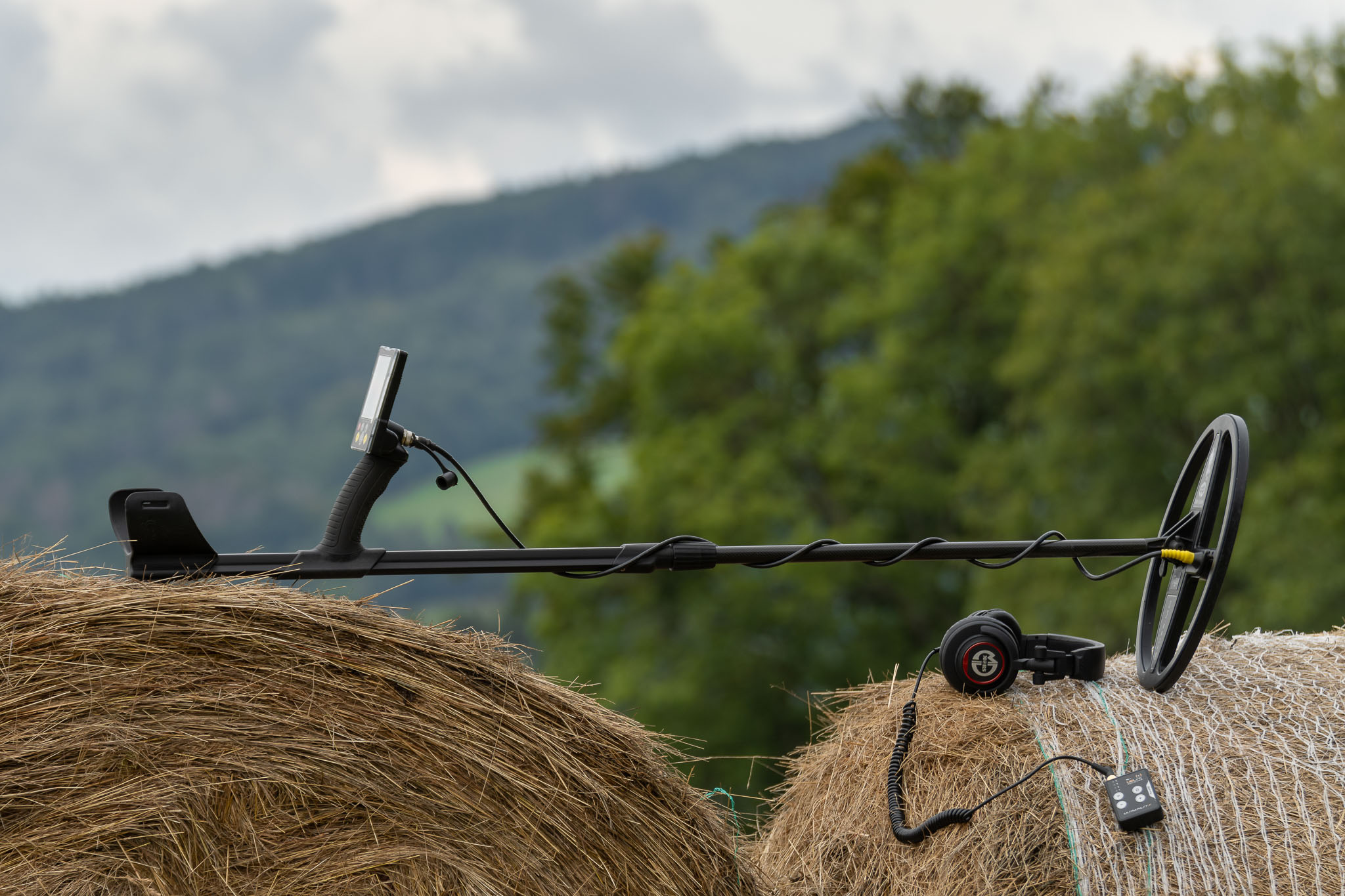
Mars Gauss is the first product of a well-known Ukrainian manufacturer of probes and accessories for metal detectors. It is known primarily for the fact that its products have always been characterized by superior quality not only in terms of functionality, but also maximum durability. I vaguely remember a video where one of the Mars probes (maybe Discovery?) was run over by some guys in an off-road car, whereupon they still put it on the detector in a single shot and the probe worked flawlessly!
When my Gauss arrived, I eagerly put it down and went looking for it immediately. It was forecast to rain for the next few days and I wanted to make the most of every spare moment. Unfortunately, five of the six days I had it on loan were totally rained out. Having been assured by Elmara that a light rain should be fine for the Gauss, I exposed the detector and myself to conditions that would not have driven a dog away. But we made it. I logged about 14 hours in the field with the detector, and did short separation and depth tests at home in the garden. After the initial familiarization, which did not go quite to my liking, I ended up sending it back really reluctantly...
Setting up the detector
The assembly of the detector is very simple, the construction is telescopic with a single bull-lock. The probe is attached classically by inserting the bottom of the rod between the eyelets with rubber washers and tightened with a plastic screw with nut. There is no need to tighten strongly, the probe holds perfectly.
An interesting feature is the possibility of moving the handle lower or higher on the structure, which helps to find the exact balance to easily guide the detector without overloading the shoulder joint and forearm. This requires a 2mm Allen wrench, but this is not included.
The control unit is fitted to the detector handle by simply snapping it on. The armrest is fixed as part of the design, without padding and in the test pack without the clamping strap, which I therefore had to borrow from another detector. Once assembled and switched on for the first time, the detector needs to be paired with the MDlink wireless module - activate audio transmission in the detector by selecting TRANS and choose the same communication channel (one of five) in both the detector and the module.
Control and MENU settings
Moving around the menu is very simple and intuitive. The setting items are logically arranged. Whether you are switching from any other detector or this is your first, getting used to the controls is a matter of no more than one search expedition.
GAIN - Sensitivity
Settings to increase or decrease the sensitivity of the detector. Not necessarily the range, as I found out in the field. For the vast majority of situations I made do with a setting of 35, with 40 being the maximum. At 35, the Gauss was very quiet, yet deep enough and sensitive enough to crumble. In the vast majority of situations it makes no sense to "juice" the detector to the max. Interestingly, the detector did not suffer from any ringing at this setting, even in stubble, tall grass or other common ground bumps.
DISC - Discrimination
This parameter can be used to define when the sounds should "break" into iron and when the detector will signal color. I usually went with the -2 setting, which suits me in cleaner sites and fields where I expect very small deep targets. Generally this setting is good for finding coins in fields, but I have also used it in the woods for large targets. I simply want to have an overview of the signal under the probe and maximum control of the audio response. Higher discrimination values may distort some signals, but are more suitable for beginners, especially in muddy locations.
FREQ - Frequency
The frequency labeled LF (Low) and variants LF1 to LF5 is the basic, or main, operating frequency of the detector with a default value of 16 kHz. Higher frequencies are marked HF (High) at 48 kHz, and you can use the five options HF1 to HF5 again according to the situation and need, e.g. In case of interference from another detector or strong influence of soil or other types of ambient interference, interference. It is good to know that LF1 and HF1 reduce the detector performance by half, LF2 and HF2 by a quarter. I recommend using these options especially on heavily to extremely mineralized soils.
In real life, I mostly walked low frequencies, especially L5, because I was most often in relatively pleasant locations with medium to low ground influence. High frequencies are recommended on heavily mineralized soils or where you expect to find a lot of small targets with low ID numbers (e.g. gold). Beware of the fact that HF versus low LF frequencies increase target ID numbers by 10 to 20 units! Before I remembered this reference from the field manual, it was a bit confusing when evaluating targets.
SEARCH - Search Mode
Offers four settings depending on the type of external conditions, especially ground effect, but also ambient temperature. The Lo (Low) setting is suitable for areas with low mineralization, typically drier, loamy and sandy soils. Not only the depth of range, but also the accuracy of target evaluation is best in such conditions. The No (Normal) parameter is useful for most sites with dry soils with low to medium mineralization. The Hi and Hi (High) modes adapt the detector to search in challenging conditions, e.g.
The hi and Hi modes also perform better in low temperatures and where targets need to be more accurately and accurately separated between waste quantities. Thus with lower range but higher accuracy. In the few search trips I managed to work mostly in Lo mode and occasionally in No. I was also going for heavily mineralized and waterlogged soils, of which we have more than enough here in the north, but unfortunately I didn't get to that due to bad weather and couldn't test the detector in that regard.
MODE - Working mode
Always uses one of three settings: an, cL and CL. The fastest, but at the same time the least processed evaluation is An (analog), where the detector does not use processor of the control unit to evaluate the signal, but presents the signals as they "climb" into the coil. In layman's terms. It is particularly suitable where there are a significant number of targets, e.g. in parks or fields with large amounts of waste.
The digitally processed signal is provided by the cL and CL (Clear ID) modes (manufacturer's technology for better signal evaluation by eliminating ground effects). In these modes, the detector processes the signal received by the probe in the detector's operational memory, evaluates it and presents it on the display in the form of displayed target ID numbers and an audible response. Compared to analog processing, the digital CL mode is slightly slower for separation, but offersThis can be a significant advantage in certain locations. The cL mode combines both of the above, i.e. the speed of analogue An and the accuracy of digital CL. It is this setting that I have used most often.
Vol and FeVol
Detector volume and iron volume: This is probably pretty obvious, adjust as needed.
TRANS - audio signal transmission
Although pairing the headphones with the control unit might seem intuitive and quick, it can take a bit of time the first time if you don't read the manual. You need to pay attention to the selected channel not only in the headphones, but also in the detector. Of course, it's such a stupid thing, the solution is quite logical after all, but I was still a bit surprised on my first outing :)
Temperature
I've been following various discussions and occasionally someone has wondered about the displayed temperature values on the controller display. The answer is just the possibility to adapt the detector to different conditions, and temperature plays quite a significant role in evaluating the signals. The displayed temperature refers to the environment inside the control unit, not the environment outside. Based on the temperature data, you can better adapt the detector to evaluate targets more accurately - see SEARCH mode settings.
Ground influence tuning
The detector uses the now notorious two main ground influence tuning options - manual (labeled Hd) or automatic (At). The modes can be changed by pressing the button with the probe and moon icons (otherwise also the "sleep" button). In the selected mode, classic "pumping" movements without contact with the ground and away from any metal targets will debug the soil influence, while in automatic mode you follow the changing values on the display and the sound response, in manual mode you have to change these values yourself with the left and right buttons. Once the values have stabilized, the ground is detuned.
The lower the values, the less the ground influence and vice versa. I've mostly been looking at low to moderately mineralized soils with values around 20. The detector responded very well to the detuning, quickly and accurately in both automatic and manual modes. For beginners, I recommend using the automatic ground balancing at first, but if the ground influence values are higher than 40, disturbing crosstalk can occur and then it is better to tune the ground manually. At very high ground influence values it is better to reduce the probe power by a quarter or half by selecting the LF2 or LF1 (or HF2 or HF1) frequencies.
Pinpont - target acquisition
Switching to Pinpont (targeting) mode using the target icon button changes the detector behavior from motion to non-movement. I.e. it is not necessary to "sweep" the probe, swing it from side to side to detect the target, but just move it freely. As the audio response increases and the indicators on the sides of the Target ID become stronger, the probe approaches the center of the target. Keep the probe at the same distance from the ground when aiming.
TIP: If the target response is too strong and prevents you from finding the exact spot to start digging, turn Pinpoint off, bring the probe closer to the target, and turn it back on. This will eliminate damage to the target and save you extra digging. Zooming out when Pinpoint is on and gradually accelerating as you approach the target works similarly. Repeating these motions will also reduce the target's audio response and refine its aim.
Design
The design of the Gauss is really quite hilarious. I like the details like the deployment unit (no more scratches when carrying in a backpack, easy charging), the adjustable position of the control unit for a precise balance tailored to each character or the magnetic charging connector. The rubberized handle fit just right in my hand and didn't slip "naked" even with a glove. The contoured construction gives a feeling of security, the guide rods and in general the whole assembly is rigid and solid. The locks hold festoon-like, without vacuums, everything looks durable. And yet the detector does not feel heavy; searching with it is very comfortable.
The clamping lugs of the well-known and popular Mars Tiger search probe are quite massive, they can obviously take a lot. After all - this parameter has long been a standard for the manufacturer's probes, proven by the experience of thousands of users. Moreover, thanks to the thick rubber washers, there is no need to tighten the plastic screw, the probe holds nicely on the structure. The cable end is protected in a fair way; apparently, Mars knows the most common weaknesses of conventional detectors. The bottom cover fits the coil structure almost perfectly. It wouldn't even come off when I was cleaning the probe before sending it back. In short, in construction and design, the Gauss is a truly hilarious instrument of first-rate quality.
Battery life and charging
I was very pleased with the ability to recharge the control unit itself, removed from the detector - you can charge it in the car or anywhere else with a USB connectionwithout having to annoy your wife in the living room or take up (her) front seat in the car with a muddy detector:) I've only charged the detector once in the few days I've been using it, even though most of the time I've been using the wireless audio transfer to headphones. The manufacturer states that the battery lasts up to 24 hours of operation.
Caution: when charging, it is IMPERATIVE to follow the following procedure: first check the magnetic connector for any dirt, metal filings, etc., then connect it to the detector unit. Only then (!) plug the cable into the adapter or charger and start charging. If you connect the cable to the power supply first and there is any dirt on the end of the cable or if the magnetic connector touches anything conductive, it could short circuit and damage the adapter. The control unit glows red at the beginning of charging, and blue after charging.
Getting to know
The first outing was typical: Slight confusion from misunderstanding the settings, large, usually round irons, massive aluminium lids, tubes or popular jars... You know the beginnings. Starting on day two, however, I can say that I have gained quite a bit of confidence in identifying targets. From that point on, I always came home with the usual field mix of ordinary coins, buttons, leadmill seals, wires, fragments of something and other such "super extra" finds. Interesting were the depths from which I dug even very small targets of a few mm!
I can't boast of any super finds, AG coins unfortunately none - I only have a couple of coins from the fields every year.r pieces that might be worth mentioning, but I guess I couldn't have expected that during those few days in our poor north. I didn't photograph the finds - I couldn't in the field as it was incredibly wet, I was covered in mud and I love my photo equipment, it just didn't have the magic at home.
In any case, after a few days I was able to use the detector quite confidently, I listened to the signals quite well, I understood the ID numbers and eventually I started to like Gauss. Really. I imagine that after a while I would have fallen seriously in love with the 15k, although at first it was a rather lukewarm to distant, neutral relationship. The first hours of the search were rather awkward for me, and both the detector and I returned home somewhat disillusioned. But it was just my problem and my pride that made me refuse to study the manual beforehand, while I naively thought I knew everything...
So I spent the next day madly translating the manual and trying to understand the detector better. I succeeded! The next search was more interesting (except for the cold wind and rain), and I finally started to understand the signals and the different settings and the consequences of their combinations. A camaraderie was born, and the bond grew noticeably with each search.
I will probably repeat myself, but I really regret that I could only test the detector for those few days. Plus, most of it was wasted, so I didn't get to go into basalts, wetlands and acidic soils, for example, where conventional detectors don't even squeak, and when they do, it's usually into iron. Therefore, contrary to my grand plans, I only managed to search through forests, meadows and fields with mild to moderate mineralizationwhere I know what signals to expect, how the soil is manifesting itself and compare it all with previous experiences.
Evaluation and conclusion
The range of the MD Gauss is really decent, the separation is very, VERY snappy and the evaluation of ID findings is quite accurate, albeit with some variance that you have to learn to reckon with. One more little note on the separation - I can't think of many detectors in this class that can separate targets in close proximity this quickly and with this quality. If you combine that with very capable iron discrimination and accurate ground tuning, you get a tool that can pick up a lot of things where others leave in disgust.
I appreciate the minimal to zero tendency to ringing when hitting hard crop ears and low undergrowth. I was incredibly comfortable with the design, and got the hang of the controls pretty quickly. The detachable control unit and charging method are seriously awesome, it will ease a lot of transportation and charging issues. As for the mounting system, I think it's pretty rigid, tight, so some sort of unhinging of the control unit on the handle shouldn't even happen over time. Overall, I have nothing but positive things to say about the design; it can probably withstand some rough handling. The only thing that bothered me was the lack of an armrest strap, but hopefully that will be included in the sales package.
For my part, I can say that for all-purpose searching on common, mild to moderate sites(I haven't had a chance to try more difficult ones), the Mars Gauss is definitely not lost in this price range. If one walks fields or sites with lots of small targets where a good separation and discrimination, they should definitely include the Gauss in their selection and feel free to try it out beforehand if considering a purchase in this price range. Especially if he requires not only quality performance from his detector, but also decent durability.
Advantages:
- Easy to use
- Large clear display
- Decent range and high sensitivity even on very small targets
- Very fast separation
- Solid discrimination
- Precise ground influence tuning
- Four-tone audio response (3 colors plus iron)
- Real-time analog signal processing capability
- 2 options for advanced digital processing of received signals (Clear ID)
- Advanced settings for challenging soil and environmental conditions
- 4 levels of backlighting
- 2 main frequencies (low 16 kHz and high 48 kHz), each with five variations for different conditions
- Low charging time (with 1000 mA / 5V adapter max 5 hours)
- Long battery life (up to 24 hours)
- High quality telescopic design
- Resistant to rain
- Adjustable handle for precise balancing of the detector
- Removable control unit
- Magnetic connector
- Can be charged via any USB source
- Can be recharged from a power bank while the detector is in operation
- Fast wireless module with no sound delay, high quality headphones
- Possibility to connect your own headphones to the wireless module
Disadvantages
- Missing armrest strap
- Weight (1340g) may be a consideration for some, but this is not noticeable due to the precise balance
- Slightly confusing increase in ID numbers when using high frequencies (hi, Hi)
Video
Sorry, I was planning to shoot a lot of footage with real user experiences directly from the field (separation and depth tests on youtube are), but considering the inclement weather, when filming was not possible, I got much less material than I originally wanted.
Roman Nemec

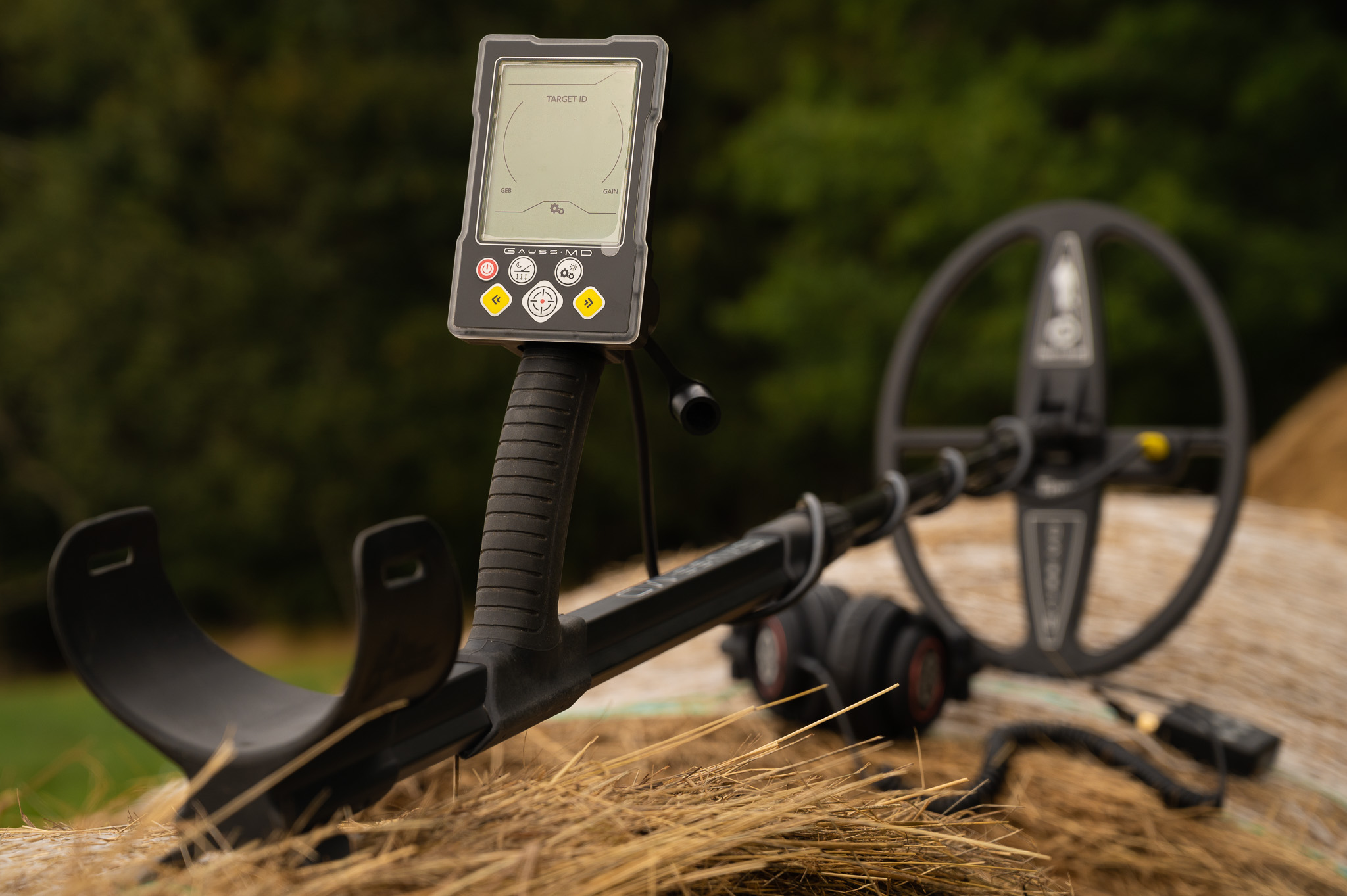
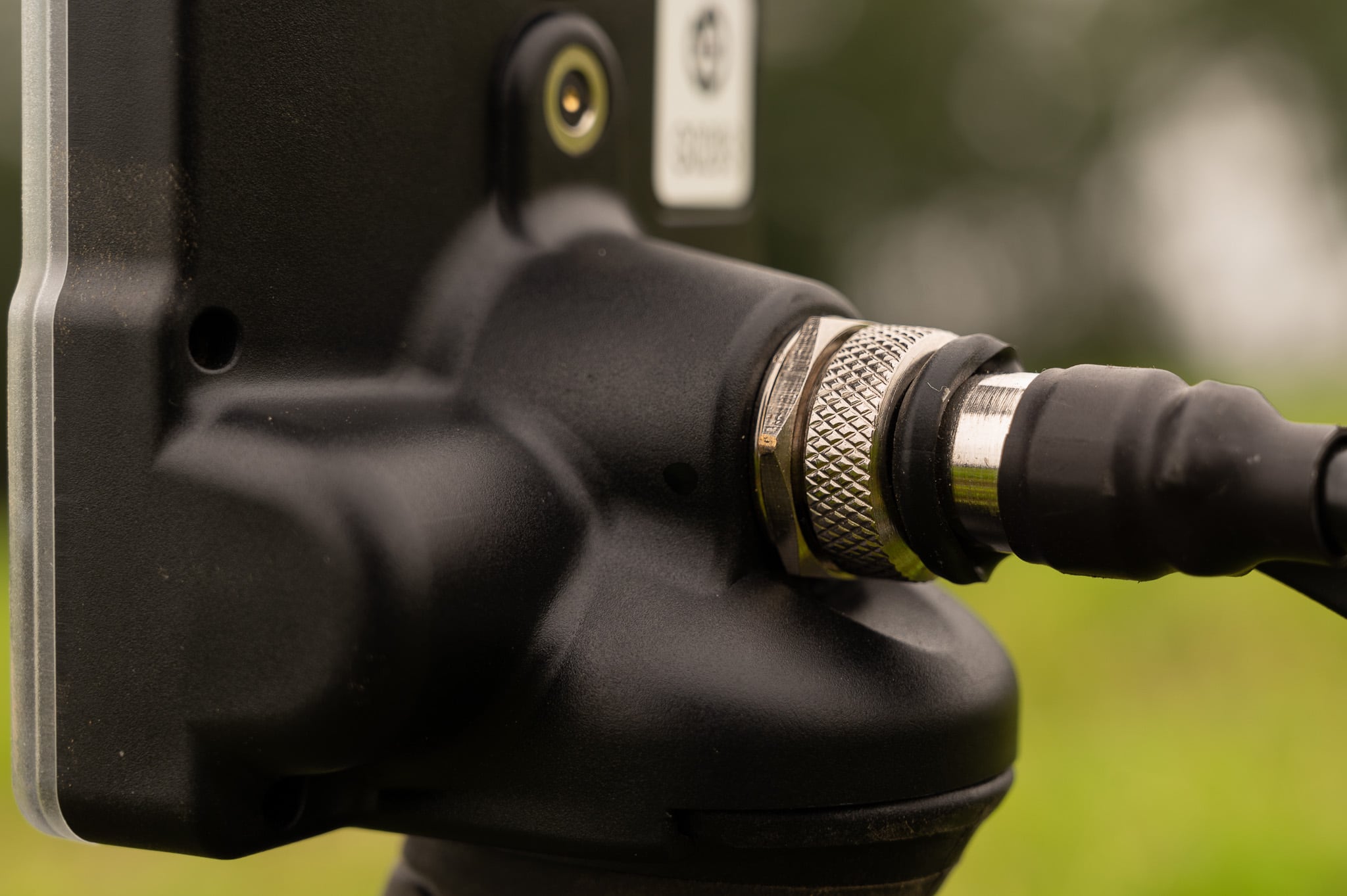
probe connector detail
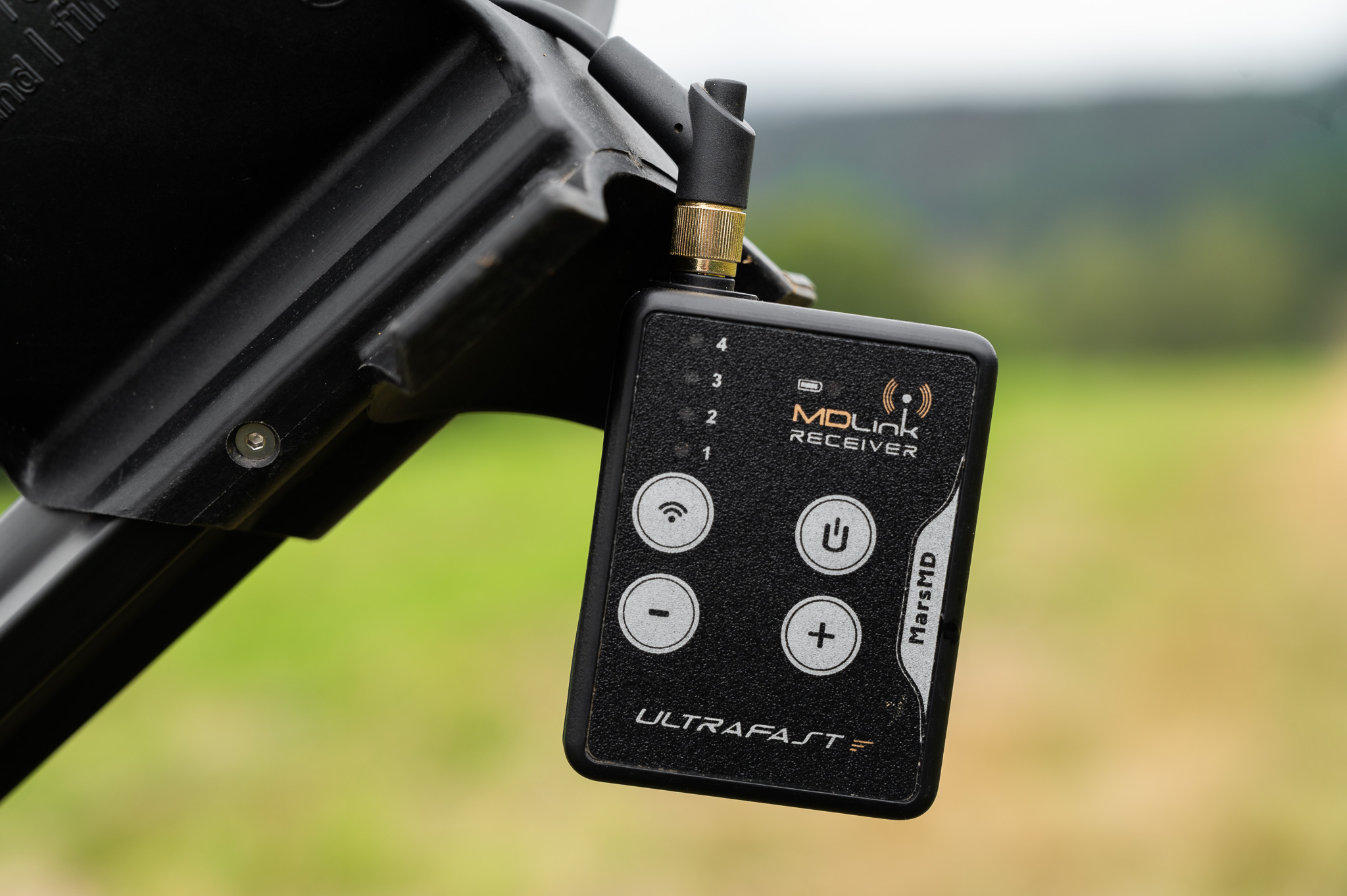
wireless module with low latency and possibility to connect any custom headphones

detail of the magnetic connector bed

detail of the control unit controls - operation is easy and intuitive

the main part of the design is profiled

it's not a hockey stick, but signals with this ID number definitely dig it

magnetic connector for easy charging - the other end is USB
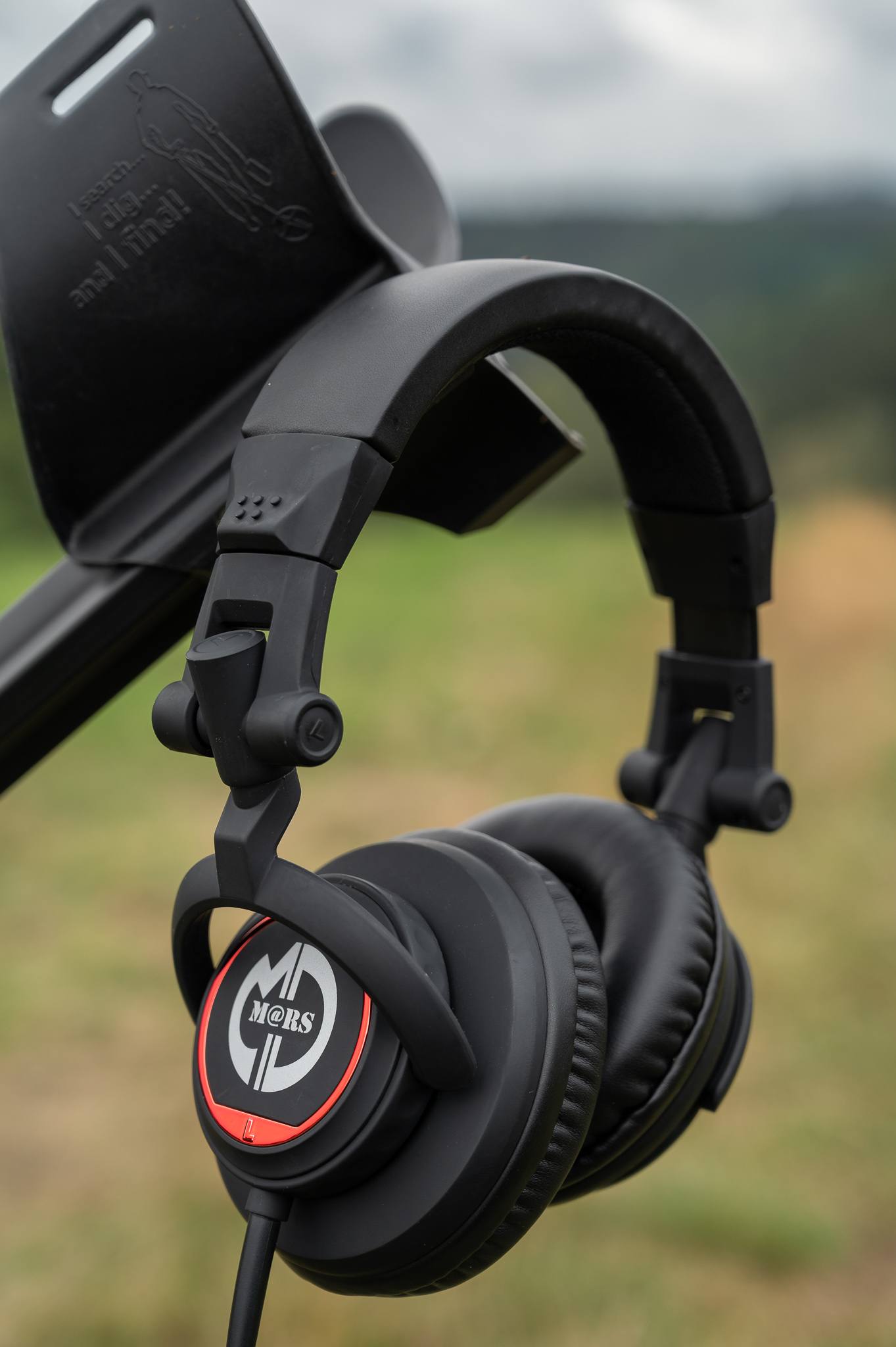
Marss headset is very solid, holds well, comfortable to wear
Mars Tiger Search Probe 25.5 x 33 cm
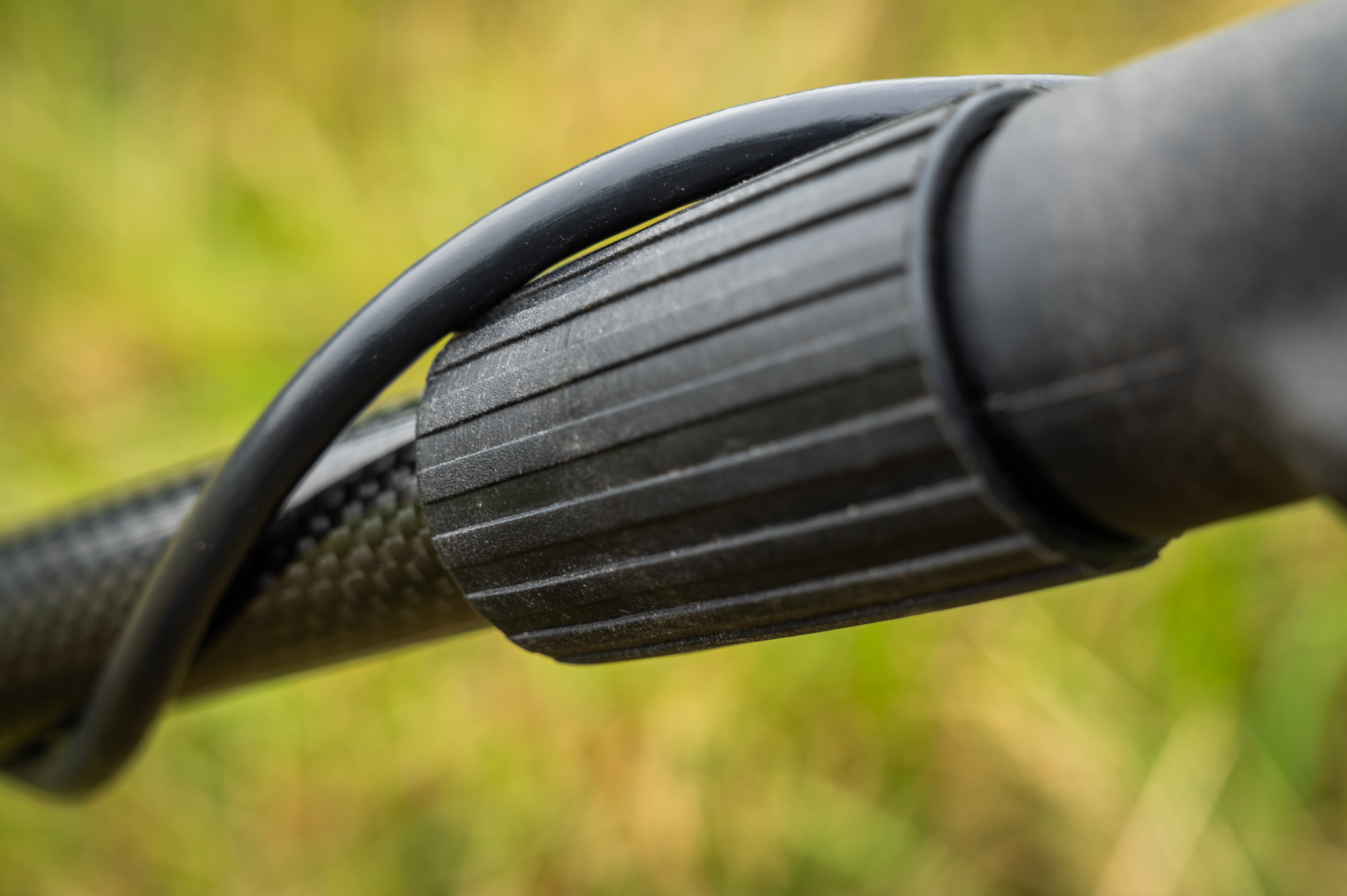
detail of the lock of the bottom bar of the structure

Mars Gauss unfolded - easy to carry, even easier to charge

handle is very comfortable and does not slip
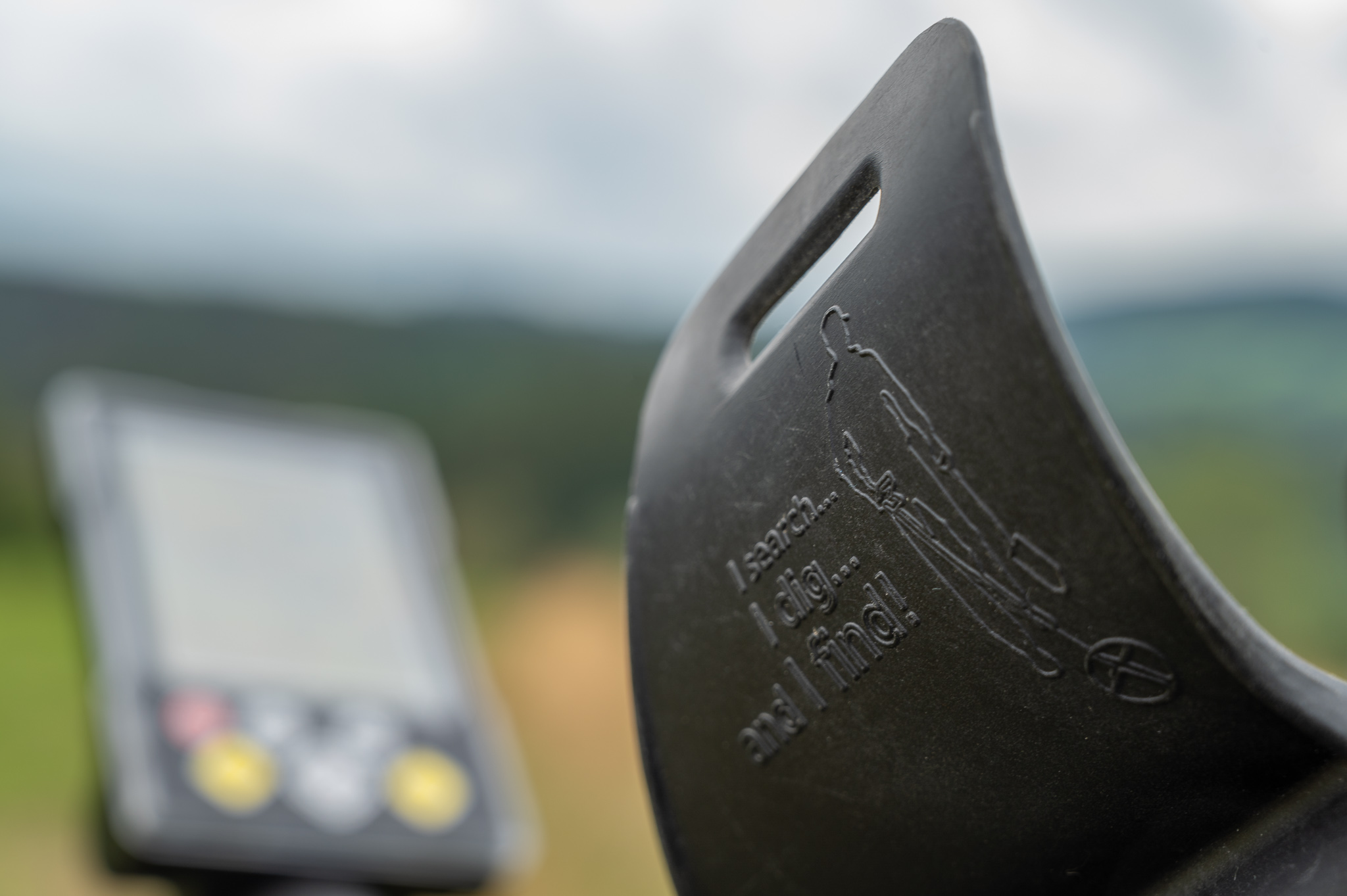
Interesting detail on the armrest - I search, dig and find
The article is included in categories:
- Archive of articles > Metal Detectors - Reviews and Tests > Mars - Reviews and tests
- Archive of articles > Metal Detectors - Reviews and Tests > Mars - Reviews and tests > Detektor kovů Mars Gauss
Post
SUPER 
Tak tohle je profesionálně odvedená práce.
Škoda nevlídného počasí, mohly být i dosahy a pak by to byla špička. A perfektní práce s kamerou, ten člověk ví co dělá.
Ahoj,díky za zajímavý test bohužel jsem se nikde nedočetl jak je na tom detektor s EMC rušením pod vysokým napětím, el. ohradníky, a železniční tratě tuto informaci spousty testujících opomíjí. Dále zda byl detektor porovnávám s jiným. Díky za odpověď
To Mysak: Já to beru spíš jako odůvodnění uživatelsky bezvýznamného zobrazení teploty stačila by pouze chybová hláška o překročení nebo podkročení teploty. Způsob vyhodnocení cíle ovlivňuje např. vlhkost a typ půdy, nízké napětí baterie detektoru, atd.
Mysak: Dobrý dotaz. Vliv teploty je zmiňován na několika místech manuálu výrobce. Nicméně jsem o něm četl i v návodech celé dalších výrobců. Domnívám se, že vnější teplota může ovlivňovat elektroniku uvnitř řídící jednotky. Ale nejsem odborník přes elektroniku. A jak píše OBI, jiná prostupnost půdou (a její odezva) je v zimě a jiná v létě. A zřejmě tam budou i další vlivy.
Brainscan: Neumím si představit, že někdo udělá detektor s ukazatelem vnitřní teploty bezdůvodně.
Pokud jde o ohradníky a dráty VN, tak jsem v blízkosti do 30 m rušení nezaznamenal. (záběr z dronu, kde za stromy je cesta a u ní ohradník, kus dál VN dráty). S Noxem jsem na stejných místech v multifrekvenci zarušenej byl. U kolejí jsem s Gaussem nechodil.
Ohledně teploty, vzhledem k tou že Gauss bude určitě počítat i s Ruským trhem, má ten teploměr svoje opodstatnění. 
Rovněž rozsah pracovní teploty vlastně od -20 je uctihodný.
Je to tam hned z několika důvodů jeden už jste tu vlastně pohotově odhalili a to že že promrzlá půda se chová jinak než normální. A výrobce s tím evidentně počítá (jak již jsem psal výše evidentně chce aby byl přístroj bez problému použitelný i v drsných podmínkách ruské Sibiře - v návodu je např. spousta postupů jak se v těchto případech chovat popř. jaký režim použít). 
Obecně každý polovodič je teplotně závislí a elektronika detektoru je jich plná. Další věc je také teplotní roztažnost materiálu, což se projevuje u sondy. Sondy jsou totiž pečlivě kompenzovány na co nejnižší signál na přijímací cívce. Takže když sondu vykompenzujete při 20 stupních v továrně, zalijete aby se vinutí sondy vzájemně nemohlo pohnout a tím změnit kompenzaci. Potom samozřejmě pokud vyndáte sondu v létě z vyhřátého auta hodnota kompenzace vlivem teplotní roztažnosti trochu změní, funguje to samozřejmě stejně i naopak když teplota klesne s rozdílem že materiál sondy se zase smrskne. Proto je výroba sondy celkem věda vyžadující jak znalosti elektrotechniky tak znalosti o mech zpracování a chování jednotlivých materiálů. Proto nejoptimálnější by byla zalévací hmota sond s vlastnostmi jako sklo, tam ale narážíte na problém že to bude křehké, takže první rána o kámen a je hotovo - prostě potřebujete nalézt nějaké optimum, což spolu s požadavkem na to aby byla sonda co nejlehčí staví výrobce do celkem nelehké situace.
Todle byl také jeden z důvodů proto se přešlo z bezpohybového systému kde se musel vlastně furt ladit prahový ton, na dnešní pohybové detektory.
Další mašina, co se musí nabíjet. Nemám k životnosti takového stroje důvěru.
No a když bude tepolm ěr ukazovat -5 tak přibalit do terénu malé patronky dynamitu  Díky ale teploměr je zbytečnost.
Díky ale teploměr je zbytečnost. 
Myslim ze -5 neni pro poradneho Rusa zadny problem 
 .Dokud nemrzne vodka tak se kope
.Dokud nemrzne vodka tak se kope 
Kim-jestli je to na tuzkovky nebo Li-ionku nema na spolehlivost zadnej vliv-oboji se da vymenit.Naopak pokud chces aby jednotka byla vodotesna nebo vodeodolna tak to v podstate ani jinak nejde. Jde o to ze kdyz budes kazdy tyden vymenovat ve vodotesnem detektoru baterky tak to sice necemu nevadi,ale je tam jedno velke ALE a to je jako ve vetsine pripadu lidsky faktor,pokud to vzdycky pri vymene vycistis omejes gumicky od pisku funguje to na 100% spolehlive,nicmene pokud budes menit baterky nekde na plazi a bateriovej blok ti spadne do pisku nebo se pisek nafouka na tesnici plochy a za zvuku skripotu ten bateriovy blok utahujes tak mas na pruser zadelano😂😂.Nastesti u vsech vodotesnejch detektoru je to udelane tak aby se voda nedostala do elektroniky ale kontakty baterie ti zkorodujou.Proto vlastne vsichni vyrobci prechazi i vodotesnych detektoru nabijeci system.Kdyz pak po case baterce klesne kapacita,vymeni se v klidu doma nebo v servisu ,vsechno se peclive v klidu utesni a jde se zpet do terenu,provozne je to taky levnejsi nez kupovat furt baterky
jaccob: mám svůj současný detektor(už muj asi 20ks) 5 let a vim že tu bude další minimálně 4-5 let fungovat skvěle. Detektoru kterému bych měl za dva roky vyměnit vnitřní baterii prostě nevěřím že vydrží, nic víc.
To GM4PRO: Díky za doplnění informací ohledně EMC rušení, pokud je pravda co říkáš tak by to mohl být zajímavý detektor do zarušených lokací. Ohledně teploměru si myslím že v je opravdu zbytečná věc ale každý má na to jiný názor. Určitě mám v plánu otestovat v mé lokalitě jestli někdy ty detektory dorazí do ČR 
Brainscan: Určitě je vždy lepší vyzkoušet, když je ta možnost.
To Kim: jasně, je daleko lepší je měnit po každém druhém hledání. Než jednou za dva roky. Což tedy stejně nesedí, EQ mám 3 roky a baterka drží na úrovni 12 hodin hledání. Navíc její výmněna je otázkou povolení 4 šroubků.
P.S: jaký teď používáš mobil na tužkovky?
Každopádně, stejně každý kdo chodí s detektorem často skončí u nějakých nabíječek. Otázka je tak jenom jak kvalitní používáte. Jediný argument proti vestavěné baterii je tak možnost výměny tužkovek v terénu. Což se dá ale řešit power bankou. Sice myslím, že většina dopadne jako já, kdy jsem si na začátku pořídil power banku a nyní mohu prohlásit, že jsem ji za ty tři roky ještě nepoužil  ... ale ten pocit jistoty v báglu
... ale ten pocit jistoty v báglu 
Elmara: nevim nač bych používal mobil, jsem stará konzerva a neberu si ho povětšinou sebou. Mám baterky vždy sebou a při dobrých tužkovkách mě vydrží v pohodě několik celodenních hledaček. Prostě se smiř s tím že jsou lidi co jedou klasiku a na nové věci si nepotrpí.  .Chápu že pro obchodníky je lepší ,když si lidi kupuji stále nové věci.
.Chápu že pro obchodníky je lepší ,když si lidi kupuji stále nové věci.
Recenze je za 👍👍👍 díky za ni. Kluci trochu nechápu smysl té výměny. Napájení přeci není otázkou kvality detektoru. Jestliže se někdo rozhodne sypat peníze do napájení po malých částkách za výměnné baterie nebo jednou za čas za vestavěnou baterii je úplně šumák. Osobně mám i powerbanku a tu využívám když hledání spojím s vandrem. Večer si já zalezu do hamaky a detík se do rána krásně dobije  Já teď naopak řeším detektor jako takový. Mám noxe a i když je to skvělý detík tak na ty vandry to úplně ideální není.. Tak to vypadá že půjdu do deuse i když srdce by si přálo Tejona
Já teď naopak řeším detektor jako takový. Mám noxe a i když je to skvělý detík tak na ty vandry to úplně ideální není.. Tak to vypadá že půjdu do deuse i když srdce by si přálo Tejona 





shadow:O nic nejde jen jsou lidi jako já ,staré konzervy 


Kim -chapu ze ses konzerva,nic proti tomu,nicmene zakaznici chteji vodotesne nebo minimalne vodeodolne detektory s vyssim krytiˇ IP - a tam uz se z duvodu co jsem psal vyse uplne pouziti tuzkovek nevyplati.Proste aktualni trh si zada todle tak na to vyrobci logicky reaguji.Ale s tim jak detektor chodi nebo kolik let ti vydrzi nema typ napajeni nic spolecneho
jaccob: Ale s tim jak detektor chodi nebo kolik let ti vydrzi nema typ napajeni nic spolecneho.To uplně netvrdim ale dobře.
No taky se do toho vložím - Powerbanku sebou taky vozím a stejně jako Elmara - ještě jsem jí nepoužil  . Co se mne týče - taky jsem říkal (Zbytkovi Jendovi který si před X lety pořídil Deuse) ty vole to bych nechtěl ani zadarmo - baterka v cívce, ve sluchátkách v jednotce. To až ti chcípne tak jsi v prd....
. Co se mne týče - taky jsem říkal (Zbytkovi Jendovi který si před X lety pořídil Deuse) ty vole to bych nechtěl ani zadarmo - baterka v cívce, ve sluchátkách v jednotce. To až ti chcípne tak jsi v prd....  . A ejhle prdlačku. Tak alespoň říkám tak až ti ty baterky odejdou tak si je vyměníš tak leda majzlíkem
. A ejhle prdlačku. Tak alespoň říkám tak až ti ty baterky odejdou tak si je vyměníš tak leda majzlíkem  No a už je to 7 let a Deus s baterkama jede jak Jůra
No a už je to 7 let a Deus s baterkama jede jak Jůra  Tedy již nepotřebuji sebou tahat drahé (kvalitní) baterky ale využívám plně vestavěný akumulátor. A že kvalitní baterky jsou opravdu potřeba mne osobně vyučil sám Elmara - když jsem šoupnul Wondery do Bounty Hunter Lan Range Pro, co jsem věnoval tehdejší přítelkyni
Tedy již nepotřebuji sebou tahat drahé (kvalitní) baterky ale využívám plně vestavěný akumulátor. A že kvalitní baterky jsou opravdu potřeba mne osobně vyučil sám Elmara - když jsem šoupnul Wondery do Bounty Hunter Lan Range Pro, co jsem věnoval tehdejší přítelkyni 



cobra:asi je to fakt o zkušenosti a nebo ochotě udělat změnu. Zatim zůstanu na svém 
Kim:přesně tak. Každému co jeho jest ;) dnes je to naštěstí tak že každý si vybere co mu vyhovuje.
To: Kim - hlavně ty tužkovky neházet po poli - už jsem jich vyhrabal mraky  (ale neber to osobně). Po Gareťákách je to memento - dnes už nedělá snad nikomu problém šoupnou to do kapsy a vyhodit tam kam se patří
(ale neber to osobně). Po Gareťákách je to memento - dnes už nedělá snad nikomu problém šoupnou to do kapsy a vyhodit tam kam se patří 
cobra: jsem už starej vůl ale ne blbec. V práci máme speciálku na baterie a hádej kdo tam jediný háže :D . 
Kim - nabíjecí baterie budou pro tebe asi velká moderna, počítám 

Když jsem šel do noxe,tak jediné co mi vadilo bylo to dobíjení,dneska bych nic jiného nebral 
namor: ne moderna ne. Ale 14 let jsme dělal ve firmě co dělala tablety a telefony. A k pevně zabudovaným baterkám mám zdravý odpor. Ale chápu že svět jde dál a technologie též.
berret: taky o něm uvažuji pokud nepřijde Fisher s něčím novým.
Já se přiznám že jsem hned po první zmínce o gausovy psal Markovy jestli ho nemůžu mít v ruce.Když ale vidím ten tlak na kluky co ho mají ani ne na týden tak je obdivuji.Napsat recenzi na detektor co jsem měl "pár" hodin v ruce je skoro nemožný.Sám jsem nebyl příznivcem noxe když přišel.Skoro jako Kim jsem ani tu baterku vevnitř nechtěl.Powerbanku jsem od cca března2019 nepotřeboval.Taky jsem s xp adventis navěřil třeba deusu ale on funguje i těch pár let bez výměny.
Ve vanquishovi nestíhám měnit. Dobíjecí už moc nevydrží a kdybych s sebou netahal plato s tužkovkama, tak bylo x krát po hledačce. Je to opruz, jsem rád za noxe 
Gauss zajímavej, recenze perfektní! 
Kim - špatně si mě pochopil. Myslel jsem dobíjecí tužkové, aby si nemusel v práci plnit ten spec.kontejner. Já si nedovedu zase představit jet pouze na obyč. AA. Používám dlouhá dlouhá léta nabíječky Eneloop a velká spokojenost. Mám několik sad a používám je úplně ve všem, i ve světle u kola.
Jsem taktéž starý konzervativec. Loď poháním vesly, bicykl šlapkami a automobil bez posilovačů. Ale petrolejku jsem uklidil do stodoly a pořídil žárovky. A je to tak supr 
namor. Ale pochopil, jsme se snažím vysvětlit jak to mám já. Stejně časem přejdu na na Minelab ,pokud se konečně Fisher nehecne udělat něco vodě odolného.
Vypadá to, že je „Fíša“ větší konzerva než ty 
namor: no hele fakt že je. Slibovali na veletrhu nějakou F80 a a ve finále jen vylepšili F75. 

Fisher má na rozdíl od mladších výrobců detektorů dostatečně široké portfolio výrobků, takže při té honbě za Minelabem stojí pevně na svých nohou.
namor: taky nenandávám je očekávám
Kim - do stého výročí založení firmy zbývá 11 let a do té doby se jistě Fisher vytasí s nějakou peckou.
Byla by škoda, kdyby se vydali cestou kopírování jako např. C-Scope a další.
namor: no bylo by to super. A doufám že Fisher nebude další v řadě koho zničí třeba corona.
To Kim: Fisher určitě corona nezníčí. Nezničila ani Whites. Ty skončili na tom, že prostě nepřišli z ničím pořádným a to roky. U Fisheru je F80 slibováná, co začal jezdit Mike Scott na Mistra hledače. A to bych řekl, že takový 8 let bude. First Texas navíc pomalu kanibalizuje sám sebe. Stačí se podívat na modely jako jsou Patriot /což je vlastně F70/ nebo Time Ranger, což je zase pro změnu F19. Náš nekonečný pláč, že by měli přijít z něčím novím, se zatím nijak neprojevil. Nové samolepky prostě donekonečna fungovat nemůžou.
I když kdo ví, teď se vyměnilo vedení a snad začnou tlačit na pilu. Fishery mám velice rád. Když jsem kdysi začínal, byl to můj vysněný detektor, na který jsem s platem 3000 kč ale absolutně neměl. (to byla doba kdy to nejlepší byla CZ7čka). Navíc vždy jsem inženýry v Minelabu a Fisheru považoval za to absolutně nejlepší co je v oboru. Něco by se snad mělo příští rok ukázat, nevíme přesně co. Minulý rok jsem na veletrhu viděl docela zajímavé PIčko, mělo i audio diskriminaci. Ale zatím nic.
To namor: co proboha kdy C.Scope okopírovalo. C.Scope a to tedy opravdu důsledně, jde pouze a jenom svojí cestou. Jelikož jsem měl možnost se podílet na projektu CS6, tak o tom vím náprosto vše. Co kdy okopírovali? Nezlob se na mě, ale tady jsi tak neskutečně vedle.....
Elmara - samozřejmě, že se jedná v mém případě o laický pohled, ale co ten Equinox design u Evo 6000? Nejsou první ani poslední, Minelab udělal, co se designu týče, obrovský krok kupředu a ostatní mají dvě možnosti. Buďto přijít s vlastním nápadem a nebo kopírovat.
Tahle cesta je ale naprosto běžná věc a např. výrobci automobilů kopírují jeden od druhého.
Pokud se pletu, beru, jsem jen laik.
Elmara:Diky za zajímavé informace. Nerad bych opouštěl či lámal hul nad značkou, kterou jsme si zamiloval. Ale konkurence je tak aktivní a výběr tak velký.
Myslím, že u vzhledu jednotky detektoru není moc možnosti co vymyslet. Je to jak s telefony. Teď jen záleží jak to poskládaj. Vodotěsnost, funkce.... cenu.
Díky za super recenzi.
Chtěl jsem původně koupit Noxe 600, ale po těchto testech si asi pořídím Gausse. Je mi hodně sympatickej... Co myslíte bude to chyba?
Mne by se libil nox na konstrukci gausse.
Chtěl bych vidět Marse běhat na čediči. Kdyby někdo zabil svůj čas a udělal video byl bych rád.
Tak to by mne zajímalo taktéž. Já často hledám v blízkosti domova a tady je toho čediče spousta (lomy po okolí a jeden zavřený prakticky u baráku)
Nuny-neboj mam to v planu 
To Namor: Ano díky novým LCD a menším součástkám jsou krabičky stále tenčí a tenčí. A více připomínají mobilní telefony. Další krok bude LCD, které vydrží špinavé prsty a pak bude ovládání dotykové. Tím směrem jdou všichni, co tam ale kdo kopíruje a co to má společného s vyhledávací technologií kteoru značka používá?
To Kim: mám první reakci od testera a struska tomu docela chutnala. Asi to tak nebude lepší než je normální stav u všech VLF
To nuny: Petr to chce taky zkusit. 
Elmara: sakra čím dal tím lepší zprávy. Děkuji za info
To s tou konstrukci neni z me hlavy. V lete na Hasofestu v Hlasne Trebani to Petr nadhodil a tak cekam az to provede. Myslim ze to bude fungovat. Ta konstrukce nema chybu.
Elmara - s technologií to nemá pranic společného, to bych si komentovat nedovolil.
Ale nemohu si pomoci Marku, Evo se odchýlilo od původního CS designu o 180° a podobnost s Equinoxem tam prostě je. A to se držím hodně zpátky se slovem podobnost.
Je škoda, že si tak stará a tradiční firma nejede svou lajnu a doufám, že např.zmíněný Fisher s novou F80 udrží emoce na uzdě.
Koukni třeba na Garett, jak to s Apexem šalamounsky vyřešili. Je vidět, že tahle úloha má řešení 
Jinak tomu vůbec nerozumím a pokud sem někoho se svým názorem urazil, tak se omlouvám.
Romane, všechny špičkové detektory už budou vypadat takto moderně. Nebo se o to budou snačit Není ani důvod dělat ty krabice tak velké, ty desky jsou dnes podstatně menší. V podstatě by to šlo udělat ještě menší, jenom k tomu není důvo, jelikož by to nebylo jak ovládat. Limitní pro rozměr tak zůstane, jak velké použiješ LCD.
K C.Scope... oni již řadu let žádný detektor s LCD nedělají. Výroba posledného projektu R1 byla ukončení před několika lety. Nemají na co navazovat, pro C.Scope je to úplně nová třída. Ale především, je to jejich vlastní detektor. Mohl bych tady vypsat hned několik detektorů, které vykradli technologie Minelabu nebo Fisheru. Ale určitě mezi nimi není C.Scope. A to samé platí pro Mars, mužeme tam hledat chybky, ale je to jejich. Což je moc hezké.
Elmara - já to samozřejmě nepopírám, vše je asi jak má být a tenhle designový směr je fajn. Minelab určil trend a je nasnadě, že se bude každý výrobce chtít tomuto směru přiblížit. To je v pořádku. Jen mohl zůstat každý z nich trochu čitelnější, tak jak tomu bylo dřív - doba před Equinoxem.
Na 100 metrů jsi bezpečně rozeznal Tesoro, Fisher, C Scope či Minelab. Rozeznat dnes na 100m Equinox od Evo 6000 nebo Gausse je prakticky nemožné. A to mi přijde smutný.
Nic víc za mou reakcí nebylo, řešil jsem pouze design.
Zmíněný Garett to s Apexem perfektně ukočíroval. Zůstalo tradiční rozložení tlačítek a pravidelným čtvercovým obrysem displeje se na dobro odlišil od obdélníkového displeje Equinoxe. Já tyhle věci prostě řeším ale už se na to vyprdnem 
To GM4PRO: Již týden testuji a v zarušené lokalitě je Gauss asi jeden z nejlepších detektorů které jsem tu měl, zatím nejhorší mi přijde zvuk tonů z reproduktoru detektoru aspoň že ve sluchátkách je to o dost lepší. ID zobrazení při 16Khz sedí +- s Alterem 71 a je velmi přesné, váhově je detektor o dost příjemnější (lépe vyvážený) než např. Vanquish 540 který jsem testoval nedávno.Uvidím co se ukáže při delším používání 
Přijde mi jako kříženec Equinoxu a Deuse což může být fajn,určitě se časem nějaké neduhy projeví a na ty jsem zvědavý, cena jak ORX nebo Eq 600 chtělo by je to porovnat přímo  a pokud už to někdo porovnával šup sem s odkazem
a pokud už to někdo porovnával šup sem s odkazem 

































